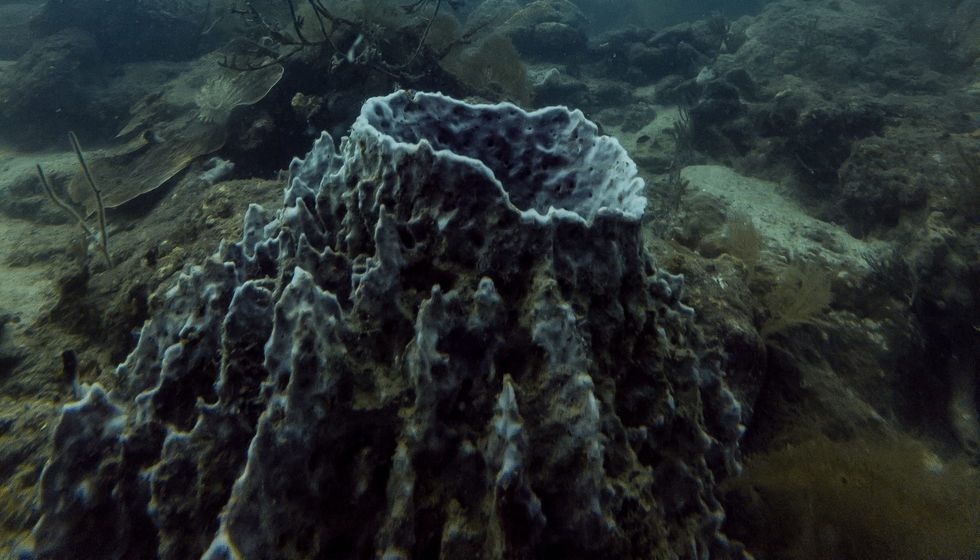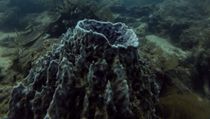The only octocoral known to produce a massive skeleton, the blue coral (Heliopora coerulea) is also known as the blue fire coral and the blue ridge coral. This soft coral generally resembles small polyp stony (SPS) corals. Unlike other soft corals, the blue ridge coral exudes a beautiful sky blue colored exoskeleton which is commonly used for decorative purposes.
The blue ridge coral possesses a hard skeleton while its body is composed of calcium carbonate and iron salts. Its structure is columnar, plate-like, or encrusting.
Within the skeleton of this hermatypic zooxanthellaete species, either blue or gray polyps are located and each contains around eight tentacles. The blue ridge coral can also be found in several variants such as tan, cream, brown, and blue colors.
In marine aquariums, blue ridge coral generally needs a strong water current, moderate to high lighting, and also needs rocks to grow. The species gets its nutrition through photosynthesis and a symbiotic relationship is shared with photosynthetic algae called zooxanthellae.
Also, they feed on several marine invertebrates and zooplankton in their natural habitat. People also feed them additional food supplements when kept in captivity, such as calcium, strontium, iodine, and trace elements which are added to the water they live in.
The International Union for Conservation of Nature has listed the species as Vulnerable. The species has to face several threats such as ocean acidification, global warming, climate change, and overfishing in the wild.
For more relatable content, check out these coral facts and giant green anemone facts for kids.
Blue Ridge Coral Interesting Facts
What type of animal is a blue ridge coral?
The blue coral (Heliopora coerulea) is a soft coral that is known by several names such as the blue fore coral and the blue coral. The species generally resembles small polyp stony (SPS) corals.
The species gets its food through photosynthesis and photosynthetic algae called zooxanthellae helps in this process. The species is also known as the blue fire coral as well as the blue ridge coral.
What class of animal does a blue ridge coral belong to?
The blue ridge coral (Heliopora coerulea) belongs to the class of Anthozoa, the family of Helioporidae, and the Heliopora genus. Only three species belong to the Heliopora genus.
How many blue ridge corals are there in the world?
The exact population of these soft corals is not known as of now but the species has been listed in the Vulnerable category of the IUCN Red List. As the global destruction of coral reefs is sadly taking place, this coral's population seems to be decreasing drastically.
Where does a blue ridge coral live?
The range of blue ridge coral (Heliopora coerulea) is quite large and this coral is found in the western-central, eastern-central, northwestern, and southwestern Pacific Ocean and the eastern and western Indian Ocean. This coral can also be found in a coral reef, such as in the Great Barrier Reef of Australia, and in Japan and the Ryukyu Islands.
The largest colony of blue ridge coral is said to be located on Ishigaki Island in southwestern Japan.
What is a blue ridge coral's habitat?
The blue ridge coral dwells in shallow water on the upper slopes of reefs and the upper hard surfaces of lagoons. They are quite close to the surface of the water and so a blue coral reef can appear when tides are low.
The species also dwells in aquariums, where a temperature range between 72-83 F (22.2-28.3 C) is suitable. In captivity, it requires a strong water current and moderate to high lighting. Rocks help in the growth of these corals as well.
Who do blue ridge coral live with?
Blue ridge corals are found in colonies, and the largest colony of blue ridge coral organisms is said to be located in the Ishigaki Island of southwestern Japan. Also, a symbiotic relationship is shared with photosynthetic algae called zooxanthellae within their habitats.
How long does a blue ridge coral live?
The exact life expectancy of the blue ridge coral is not known as of now but similar species such as the elkhorn coral live for around 10-12 years. Studies reveal that some coral species can live for more than 4,000 years.
How do they reproduce?
Very little is known about the breeding patterns of the blue ridge coral (Heliopora coerulea) but it is believed that the species follows similar methods to other corals. Corals are either unisex or hermaphrodites and they can reproduce either by sexual or asexual modes of reproduction.
In the asexual mode of reproduction, the size of the colony increases when individual coral polyps create an exact copy of themselves.
Several factors such as heavy wave actions, storms, tides, and ship disturbances also play a major role in breaking the branches of coral reefs and moving them to other marine regions. These fragmented corals form new colonies, where the new corals are very much similar to those of the parent colony.
In the sexual mode of reproduction, the breeding season is not known but males and females release millions of gametes at the same time into the water column in the coral reef to reproduce. The coral larvae float on the water surface until they metamorphose into colonial polyps and form new colonies.
What is their conservation status?
The International Union for Conservation of Nature has listed the blue ridge coral as Vulnerable. This marine species has to face several threats such as ocean acidification, global warming, climate change, and overfishing in the wild. As the global destruction of coral reefs is taking place, blue ridge coral reef habitats are diminishing drastically.
Blue Ridge Coral Fun Facts
What do blue ridge coral look like?
Blue ridge coral (Heliopora coerulea) possess a hard skeleton while their bodies are composed of calcium carbonate and iron salts. Their structure is columnar, plate-like, or encrusting.
Within the skeleton of the hermatypic zooxanthellaete species, either blue or gray polyps are located and each contains around eight tentacles. The blue ridge coral can also be found in several variants such as tan, cream, brown, and blue colors. This coral (blue ridge) species is also known as the blue fire coral.
How cute are they?
This soft coral is quite fascinating, and the species even attracts tourists all over the world. Also, their hard plate-like structure and thick branches look quite intriguing.
How do they communicate?
Very little is known about the behavior of this coral (blue ridge) at the moment but these corals generally communicate most during the breeding season. Also, some coral species even possess venomous nematocytes. When an intruder comes close to these polyps, the polyps release this chemical.
How big is a blue ridge coral?
The average length of this coral (blue ridge) is around 35.43-39.47 in (90-100 cm). Species such as the fire coral and the brain coral are twice the length of this blue coral reef.
How fast can a blue ridge coral move?
Like other corals, blue ridge corals are not able to move. Corals are fixed in one place and generally live and prey without moving.
How much does a blue ridge coral weigh?
The exact weight of this marine species is not known.
What are their male and female names of the species?
No specific name is used to refer to male and female blue ridge coral organisms.
What would you call a baby blue ridge coral?
The term planula is used to refer to baby blue coral organisms.
What do they eat?
They feed on several marine invertebrates and zooplankton in their natural habitat. People also supply them with additional food supplements such as calcium, strontium, iodine, and trace elements.
These are added to the water that this marine species lives in. Also, a symbiotic relationship is shared with photosynthetic algae called zooxanthellae. Meanwhile, small marine species such as snails and fireworms feed on coral reefs.
Are they poisonous?
Yes, these blue color corals that are found in coral reefs are poisonous.
Would they make a good pet?
The species is listed as Vulnerable and is quite rare but they can easily survive in aquariums and tanks if the proper temperature and pH level is maintained. In aquariums, they need a strong water current, moderate to high lighting, and they also need plenty of rocks.
Did you know...
The toxins found in many coral reefs can kill humans.
The blue coral is not a plant.
Is blue coral natural?
Yes, blue corals are not dyed and their blue color is natural. They are composed of calcium carbonate and possess a blue skeleton.
Is blue coral soft coral?
Yes, the blue coral is a soft coral.
Here at Kidadl, we have carefully created lots of interesting family-friendly animal facts for everyone to discover! Learn more about some other scyphozoan from our jellyfish facts or moon jellyfish fun facts pages.
You can even occupy yourself at home by coloring in one of our free printable blue ridge coral coloring pages.









